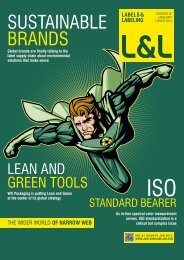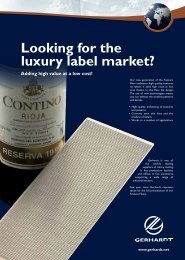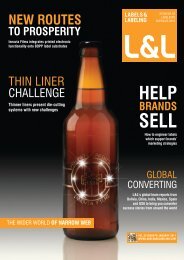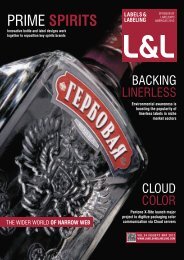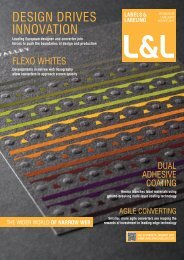THE DATA FRONT
Download as PDF - Labels & Labeling
Download as PDF - Labels & Labeling
- No tags were found...
You also want an ePaper? Increase the reach of your titles
YUMPU automatically turns print PDFs into web optimized ePapers that Google loves.
106 | l&l<br />
Offset opportunities<br />
The latest developments in web offset technology is making the process more attractive for<br />
shorter runs and increasing in-line options available to converters. Andy Thomas reports<br />
The new generation of web offset presses are designed to<br />
open up new, shorter run markets previously closed to offset<br />
by high levels of makeready waste and inflexible repeats.<br />
The new Nilpeter MO-4 offset press, successor to the<br />
MO-3300, typifies these trends. The key development on the<br />
MO-4 is the use of sleeves for plate and blanket cylinders.<br />
‘The cost of the aluminum-based sleeve system is around a<br />
fifth of the price of an offset cassette,’ notes Jakob Landberg,<br />
global sales and marketing director at Nilpeter. The sleeves are<br />
mounted on hydraulic expansion shafts, allowing fast changes<br />
between jobs.<br />
Nilpeter’s Easy Load sleeve system is already in place for<br />
plate and anilox cylinders and screen units on the FA-4 press,<br />
and this standardized system allows print and converting<br />
technologies to be switched quickly on the offset platform.<br />
To facilitate the change from offset to hot foil printing, Nilpeter<br />
has designed the impression roller as an interchangeable<br />
sleeve, with a rubber or steel surface depending on the printing<br />
method. This means there is no need to break the web when<br />
switching between processes or impression rolls, greatly<br />
reducing set-up times and waste.<br />
The MO-4 has a more comprehensive servo drive<br />
implementation than its predecessor. Each print unit has<br />
independent drives for the plate sleeves, blanket sleeves<br />
and impression rolls. Similarly with the length and lateral<br />
registers. When any corrections to lateral register are made,<br />
the complete unit –inking unit, plate and blanket cylinder – is<br />
moved, avoiding color profile modifications.<br />
A print cylinder insert with sleeve<br />
technology for a 520mm print width<br />
The MO-4’s inking train has been redesigned for additional<br />
stability. Two inking rollers have been added to each inking<br />
unit along with stronger sidewalls, while a total of three rollers<br />
can now be temperature controlled. Individually programmable<br />
dampening curves maintain constant ratios of moistening and<br />
ink delivery across all machine speeds.<br />
Rotatek is another narrow web manufacturer moving down the<br />
offset sleeve route, with its new Universal press, a 500mm-wide<br />
machine operating at speeds up to 350 m/min and featuring<br />
the company’s recently patented lightweight offset sleeves with<br />
steel bearers. The press runs both UV and EB inks. Its modular<br />
design supports various in-line options including hot stamping or<br />
cold foil, rotary screen and rotogravure units, and it will convert a<br />
wide range of materials, including unsupported film, from 30-400<br />
microns.<br />
A flexo unit was introduced at Labelexpo mounting lightweight<br />
sleeves on servo-driven plate and anilox cylinders. A chambered<br />
doctor blade is optional for high speed reel-to-reel applications.<br />
From sheets to rolls<br />
Web offset has proven particularly popular with converters<br />
making the transition from sheetfed into roll-fed labels. One such<br />
company is Hammer Packaging in the US, which installed its<br />
first Drent Goebel Variable Sleeve Offset Printing (VSOP) press<br />
in 2006, a 33.5in wide VSOP 850 machine. Early this year the<br />
company finished installation of a second, similarly specified<br />
press.<br />
‘Both machines offer short make ready times, quick repeat size<br />
The ghost of Giebeler<br />
SDF will be a new name to many in the labels industry, but this young<br />
company has just filed a patent on a sleeve offset print station design.<br />
The core of SDF is former engineers, service technicians and mechanics<br />
from Giebeler – one of the ‘big three’ business forms press manufacturers,<br />
along with Goebel and Grapha in the 1970s and ‘80s.<br />
According to Karl Hallwas, SDF technical manager, the Giebeler<br />
successor company filed a patent for sleeve printing cylinder inserts back<br />
in November 1999, before its competitors – including Drent and Grapha<br />
(now part of Muller Martini). Development of the sleeve system came to a<br />
standstill after the company’s insolvency in the same year.<br />
SDF’s wet-offset printing unit mounts the printing cylinder insert<br />
with plate, rubber blanket and counter impression cylinder. Standard<br />
circumference is from 20-28”, but larger formats of 28-36” and 36-44” are<br />
available. Printing widths can range from 520-920 mm.<br />
The plate and counter impression cylinder are in a fixed position, with<br />
the rubber blanket cylinder brought into printing position according to the<br />
printing format.<br />
The sleeve is changed through the frame wall and the support cylinder<br />
remains in the insert frame. The mounting of the sleeve body on the<br />
support cylinder is hydraulic, and the plate cylinder is equipped with<br />
diagonal adjustment to allow limited register correction. Only the plate<br />
and rubber blanket cylinder are separately driven, reducing electronic and<br />
mechanical complexity.<br />
As well as offset print cylinders, rotogravure, flexo and screen print<br />
inserts can be installed into the same frame opening.<br />
Labels&Labeling





